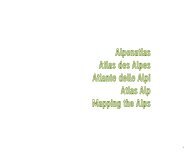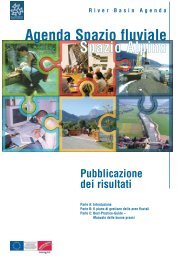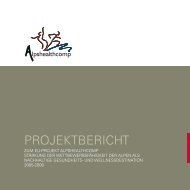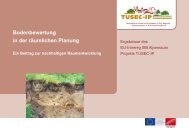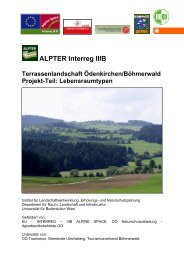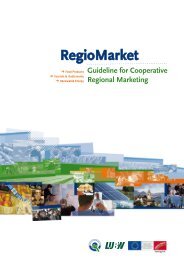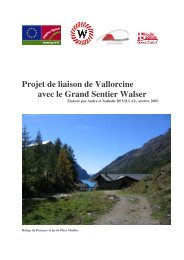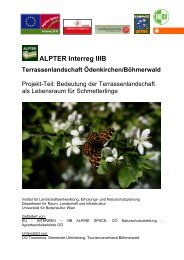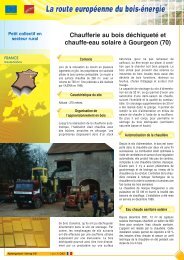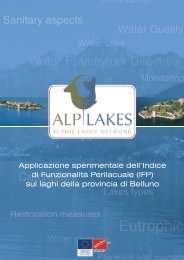WALSERSPRACHE - The four main objectives of the Alpine Space ...
WALSERSPRACHE - The four main objectives of the Alpine Space ...
WALSERSPRACHE - The four main objectives of the Alpine Space ...
You also want an ePaper? Increase the reach of your titles
YUMPU automatically turns print PDFs into web optimized ePapers that Google loves.
Ugo Busso<br />
Issime, where <strong>the</strong> dialect had been exclusively spoken, whereas in Gressoney literary<br />
German had been widespread since at least <strong>the</strong> end <strong>of</strong> 1800. Work got underway under<br />
<strong>the</strong> direction <strong>of</strong> Corrado Grassi, Albert Linty, Luciana Landi and Alys Barell. All entries<br />
were recorded and <strong>the</strong>n evidence provided by informants from both Gressoney and Issime<br />
was entered. Pr<strong>of</strong>essors Renato Perinetto and Peter Zürrer became involved. In 1981<br />
Renato Perinetto published <strong>the</strong> first grammar <strong>of</strong> Töitschu and Peter Zürrer two monographic<br />
studies on Gressoney’s Titsch, which led to his recent book, Sprachinseldialekte:<br />
Walserdeutsch in Aostatal in 1999 (“Dialects from Linguistic Islands: Walser German in<br />
<strong>the</strong> Aosta Valley”; it is currently being translated into Italian). In 1988 <strong>the</strong> Augusta<br />
Association and <strong>the</strong> Cultural Centre published <strong>the</strong> Italian-Titsch and Italian-Töitschu dictionaries.<br />
In 1998 two additional volumes appeared with <strong>the</strong> languages reversed. At <strong>the</strong><br />
same time many poems, songs, teaching manuals and cooking books were published in<br />
French, Italian and German. A vast collection <strong>of</strong> proverbs from our Walser communities<br />
is also about to be published. Meantime <strong>the</strong> two vocabularies were voice recorded. Many<br />
testimonials were and are being recorded as well. In 2004 our Association was recognised<br />
for financial help by <strong>the</strong> Intereg IIIA Italy-Switzerland program for a project called “Walser<br />
<strong>Alpine</strong>, Cultural and Rural Landscape”. Many rock buildings from <strong>the</strong> alpine landscapes<br />
<strong>of</strong> Stein and Betti were thus assessed, in a pilot project labelled “Stone and Lumber Cultural<br />
Lab”. Hand in hand with <strong>the</strong> Walser Cultural Centre we also organise cultural outings<br />
and take part in <strong>the</strong> Walsertreffen (General Walser Convention) every three years. We also<br />
cooperated with <strong>the</strong> Issime township in renaming in Töitschu various hamlets and boroughs<br />
as well as in setting up a native language service wicket. We also write articles for<br />
<strong>the</strong> Messenger Valdôtain. It is somewhat odd that two neighbouring Germanic communities<br />
like Gressoney and Issime may have dialects so removed from each o<strong>the</strong>r to turn oral<br />
communication into a problem. That is perhaps due to <strong>the</strong> fact that Gressoney’s dialect<br />
evolved in time, while Issime re<strong>main</strong>ed frozen in its original form. Nowadays <strong>the</strong> use <strong>of</strong><br />
Walser dialects in Issime and Gressoney for everyday conversation is becoming rarer and<br />
modern occurrences find no words in a thousand-year old language. On <strong>the</strong> o<strong>the</strong>r hand<br />
both dialects have been completely codified and hardly one expression relating to rural or<br />
mountain life has not found an entry in dictionaries or in recordings. Personally I never<br />
dismiss <strong>the</strong> opportunity to express myself in my unforgettable Töitschu, even when delivering<br />
my Sunday sermons.<br />
37



